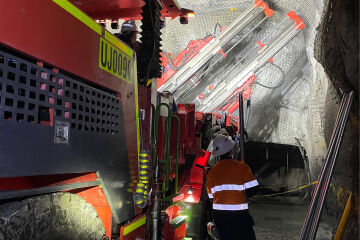min read time
Rock solid - Leonie's research goes global
As miners dig deeper than ever before to optimise the reserves of existing open pit mines, the geotechnical community has focused on how to best ensure the stability of the unprecedented heights of today’s spoil dumps.
Thiess Principal Engineer Dr Leonie Bradfield is sharing the results of her research into the shear strength of spoil dumps with the global community, most recently at the Tailings and Mine Waste Conference in Colorado.
Her research began in 2011, when Leonie was approached by prominent global geotechnical practitioner Dr John Simmons to lead a research project out of the University of Newcastle.
Funded by the Australian Coal Association Research Program (ACARP), with in-kind support from Thiess, Leonie investigated and designed a way to reliably estimate the shear strength of spoil dumps at unprecedented heights.
“Traditionally, spoil dumps at open pit mines rarely exceeded 90 metres in height, but the dumps of modern times are commonly exceeding heights of 250 metres,” Leonie explains.
“The industry was still using guidelines developed from small-scale laboratory tests, adjusted by back analyses of failed dumps up to 120m in height. They were adequate for the dump heights in the 1970s and 1980s, but not reliable for today’s and future conditions.”
Big John
Leonie spent the next three years designing, then constructing and operating a large direct shear machine, affectionately known as ‘Big John’, to provide reliable design information for current and planned high dumps.
“Designing ‘Big John’ ended up being the easy part of the project – building the machine and completing the testing regime was a monumental exercise!” Leonie said.
“Leading a team of technical tradespeople, I had to put my head back into the books to teach myself what I needed to know about structural and mechanical engineering to design every fine detail - from the size of the steel beams in the reacting frame, right down to the type of penetration in the welds.”
The machine tests at a much larger scale, in terms of combined specimen size (720mm x 720mm x 600mm) and stress (up to 4.6MPa), than has ever previously been achieved using a direct shear machine for geotechnical testing of rockfill.
Global resource
Leonie’s findings are part of a global publication Guidelines for Mine Waste Dump and Stockpile Design and her research has captured the attention of the global geotechnical community, particularly in Canada and the northern states of America.
Leonie has spent the past six months in this northern hemisphere region as a Technical Project Manager leading a Task Force to address the issues of soft ground conditions.
“‘Big John’ still resides in the laboratories at the University of Newcastle and is now being used by the industry at large to test samples and provide reliable design information,” Leonie said.
“The results of these tests are redefining the strength and stability guidelines for spoil dumps and providing a framework for us all to work to moving forward,” Leonie said.
The Tailings and Mine Waste Conference is an annual event hosted by the Department of Civil and Environmental Engineering at Colorado State University in conjunction with the Universities of Alberta and British Columbia – all leading institutions in the studies of geotechnical science. It is a forum for mining and associated industries and government bodies to come together on a regular basis to discuss the issues and developments in tailings and mine waste management.



